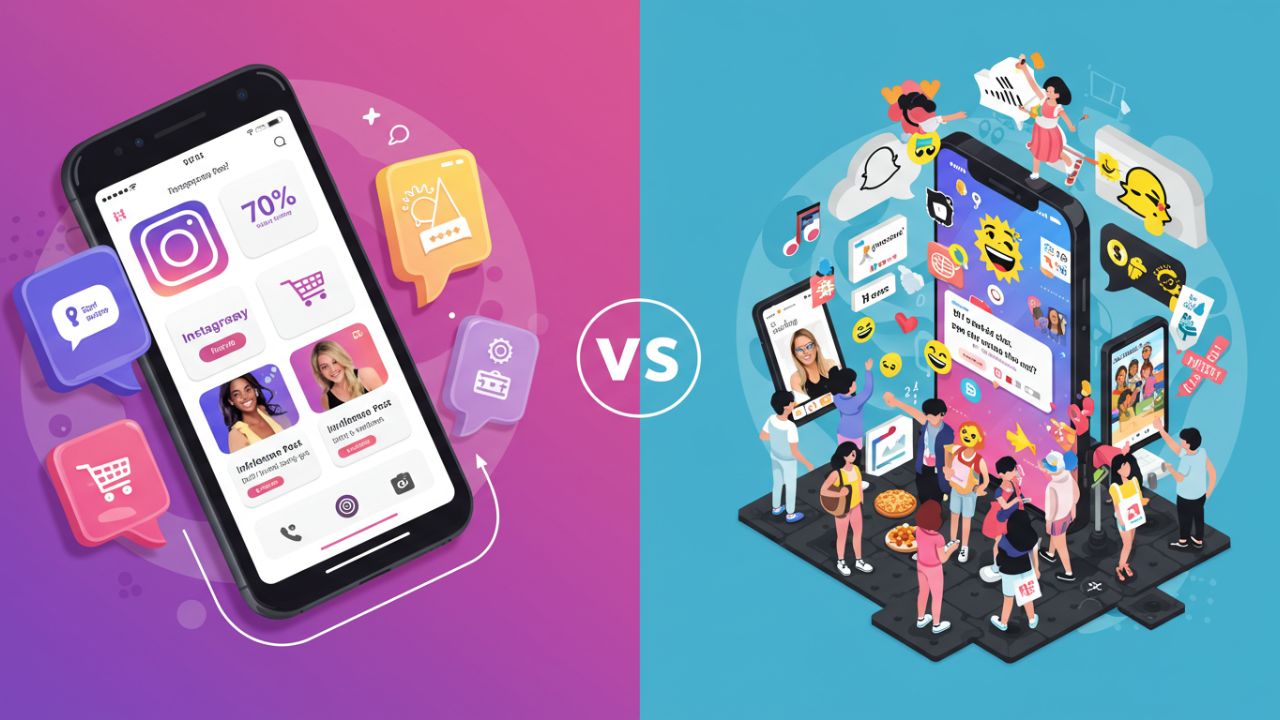In the ever-evolving world of social media, two names consistently appear in discussions about where businesses and creators should invest their time, creativity, and advertising budgets: Instagram and Snapchat. While Instagram, owned by Meta (formerly Facebook), dominates the global social media landscape with over 2 billion monthly active users, Snapchat thrives as a unique platform for authentic, short-lived content with an audience of more than 420 million daily active users.
The question for marketers, entrepreneurs, and investors is not whether either platform is effective—it’s which platform provides the better return on investment (ROI) for your goals.
This article explores audience demographics, engagement rates, advertising tools, content styles, monetization opportunities, and future trends to help determine whether Instagram or Snapchat is the better investment.
1. Audience Demographics: Who’s Watching?
A platform’s value begins with who uses it. Let’s compare:
| Factor | Snapchat | |
|---|---|---|
| Monthly Active Users | ~2 billion | ~420 million daily |
| Age Range | 18–44 core, but expanding | 13–24 dominant |
| Geographic Reach | Global | Stronger in North America & Europe |
| Gender Split | ~52% female, 48% male | ~58% female, 42% male |
| Household Income | Broad spectrum | Higher representation in mid-to-high income Gen Z households |
- Instagram has a broader, more diverse audience across all age groups, making it better for brands seeking global visibility.
- Snapchat is laser-focused on Gen Z and younger millennials, often reaching people that spend less time on traditional social platforms.
👉 If your brand targets Gen Z, students, or younger consumers, Snapchat offers a more direct reach. For a wider demographic, Instagram is more reliable.
2. Content Styles: Stories vs. Reels vs. Snaps
Both platforms specialize in visual-first content, but the way users consume content differs.
- Instagram:
- Stories (24-hour disappearing content)
- Reels (short-form TikTok-style videos)
- Feed posts (photos, carousels, videos)
- Shopping posts (integrated e-commerce)
- Snapchat:
- Snaps (photos/videos, ephemeral)
- Stories (personal & Discover)
- Spotlight (short-form viral videos)
- Augmented Reality (AR) filters
📌 Key takeaway:
- Instagram offers a multi-format ecosystem suitable for both short-term virality and long-term branding.
- Snapchat thrives in authentic, raw, and private interactions, excelling with AR and disappearing content.
3. Engagement Rates
Engagement is where things get interesting.
- Instagram average engagement rate: ~0.60% (varies by industry).
- Snapchat engagement rate: Harder to quantify, but studies suggest users spend 30+ minutes daily on the app, with high completion rates for Stories.
Why this matters:
- Instagram has larger reach but lower organic engagement due to algorithm saturation.
- Snapchat has smaller reach but deeper, more personal interactions.
👉 Brands looking for mass awareness should lean Instagram. Brands seeking stronger daily engagement with younger audiences should test Snapchat.
4. Advertising Opportunities
| Feature | Instagram Ads | Snapchat Ads |
|---|---|---|
| Formats | Stories, Reels, Feed, Shopping, Explore | Snap Ads, Story Ads, Collection Ads, AR Lenses |
| Targeting | Advanced (Meta ecosystem: behaviors, interests, lookalike audiences) | Strong with location-based & demographic filters |
| E-commerce | Instagram Shopping (seamless checkout) | Swipe-up links, less robust shopping |
| Cost per Click (CPC) | $0.70–$1.00 avg. | $0.50–$0.80 avg. |
| Best For | Large-scale campaigns, influencers, product catalogs | Gen Z-focused brands, experiential AR campaigns |
Instagram’s biggest strength is its integration with Meta Ads Manager, giving advertisers unparalleled targeting.
Snapchat shines with immersive AR campaigns—great for fashion, beauty, and entertainment.
5. Influencer Marketing
- Instagram influencers dominate the creator economy. The platform is the #1 hub for brand collaborations, with built-in creator marketplaces.
- Snapchat influencers (Snap Stars) are fewer, but their audiences are highly loyal.
👉 If you need influencer partnerships at scale, Instagram wins. If you want authentic Gen Z influencer engagement, Snapchat may outperform.
6. Monetization & Creator Tools
| Feature | Snapchat | |
|---|---|---|
| Creator Fund | Bonus programs (Reels Play, ad revenue sharing) | Spotlight payouts, Snap Star earnings |
| E-commerce Tools | Shops, product tags, checkout | Limited but testing commerce integrations |
| Direct Earnings | Subscriptions, gifts, affiliate | Gifts, Spotlight payouts |
| Long-term Viability | Strong Meta support | Still evolving monetization model |
Instagram is better for professional creators seeking multiple income streams.
Snapchat offers potentially higher visibility for new creators due to Spotlight.
7. Case Studies
- Nike: Runs large-scale global campaigns on Instagram, leveraging Shopping + Reels.
- Taco Bell: Snapchat AR Lens for Cinco de Mayo reached 224 million views in a single day.
- Small Beauty Brands: See faster traction on Snapchat due to AR try-ons.
8. Future Trends
- AR & VR Growth
- Snapchat leads in AR. Its AR Lenses have become cultural phenomena.
- Instagram is catching up but remains focused on Reels competition with TikTok.
- E-commerce Expansion
- Instagram is integrating deeper shopping experiences.
- Snapchat is experimenting with AR-powered shopping.
- AI-Driven Personalization
- Both platforms are investing in AI recommendation engines.
- Instagram focuses on content discovery (Reels algorithm).
- Snapchat focuses on AI chatbots (My AI) to enhance user experience.
9. Strengths & Weaknesses
| Platform | Strengths | Weaknesses |
|---|---|---|
| Global reach, e-commerce, influencer dominance, ad targeting | Lower engagement saturation, algorithm competition | |
| Snapchat | Gen Z focus, AR leadership, authentic engagement | Smaller user base, weaker monetization tools |
10. Final Verdict: Where to Invest?
- Invest in Instagram if…
- Your goal is global reach and diverse audiences.
- You want e-commerce integration.
- You rely heavily on influencer partnerships.
- Invest in Snapchat if…
- Your target audience is Gen Z.
- You want authentic, private engagement.
- You aim to innovate with AR campaigns.
📌 Balanced Strategy Recommendation:
- Use Instagram as your primary platform for brand awareness, shopping, and influencer marketing.
- Use Snapchat as your secondary, experimental platform to engage Gen Z with creative AR-driven campaigns.

Leave a Reply